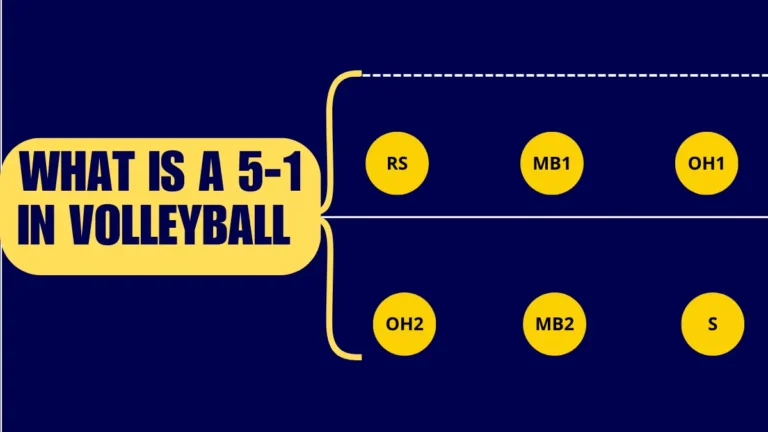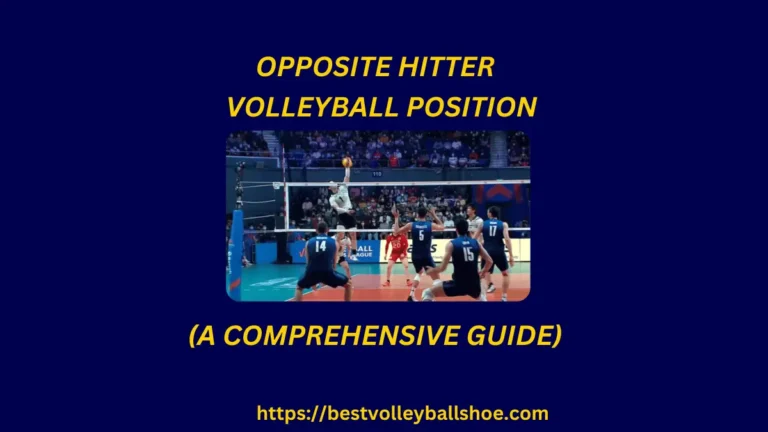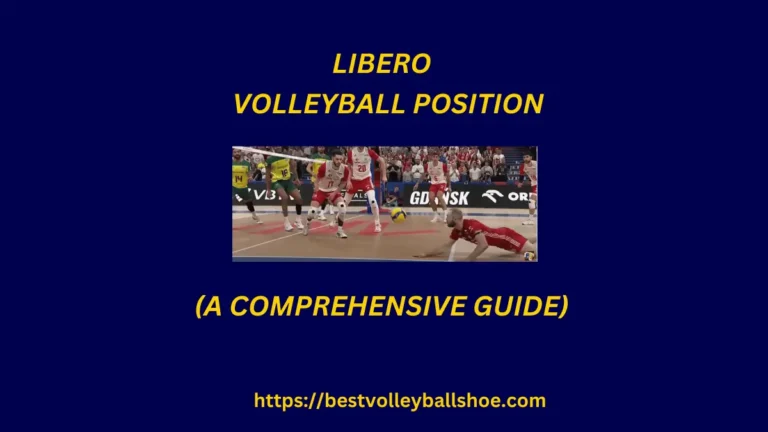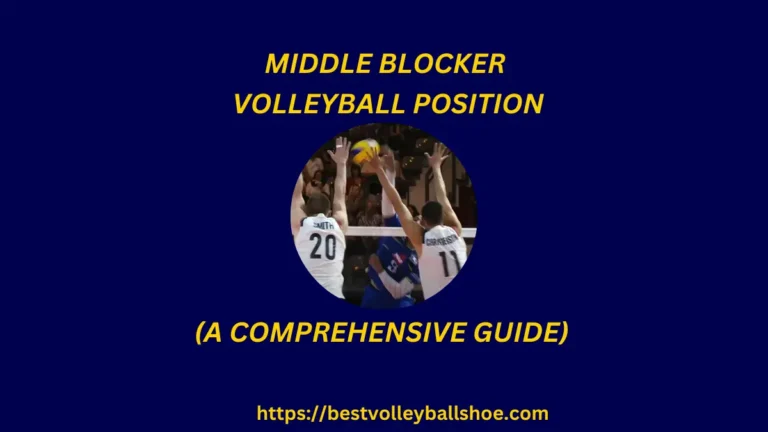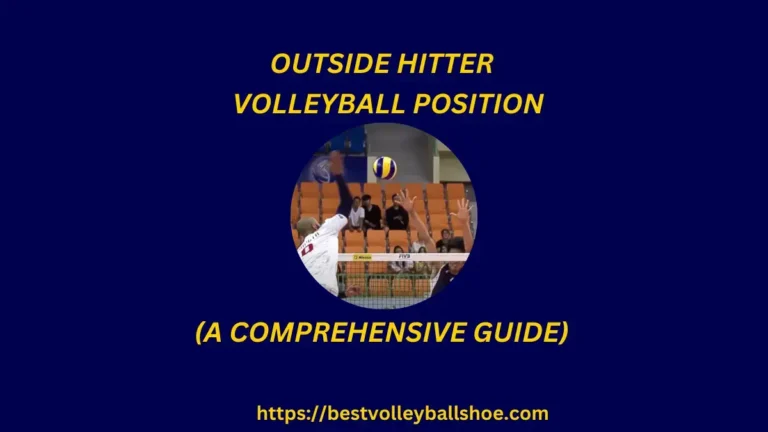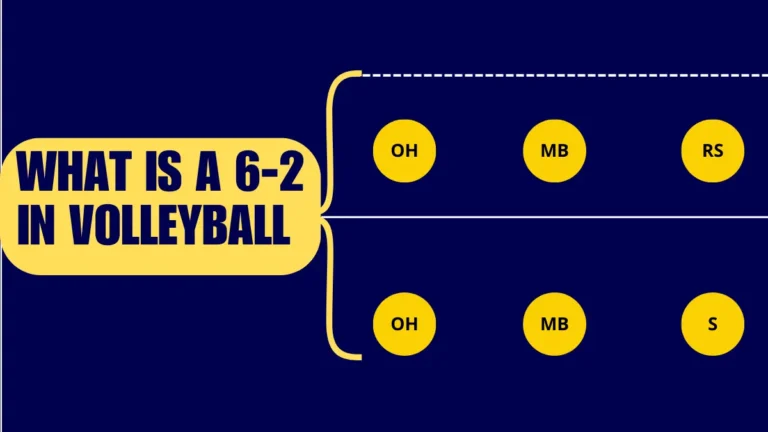Setter Volleyball Position: A Comprehensive Guide
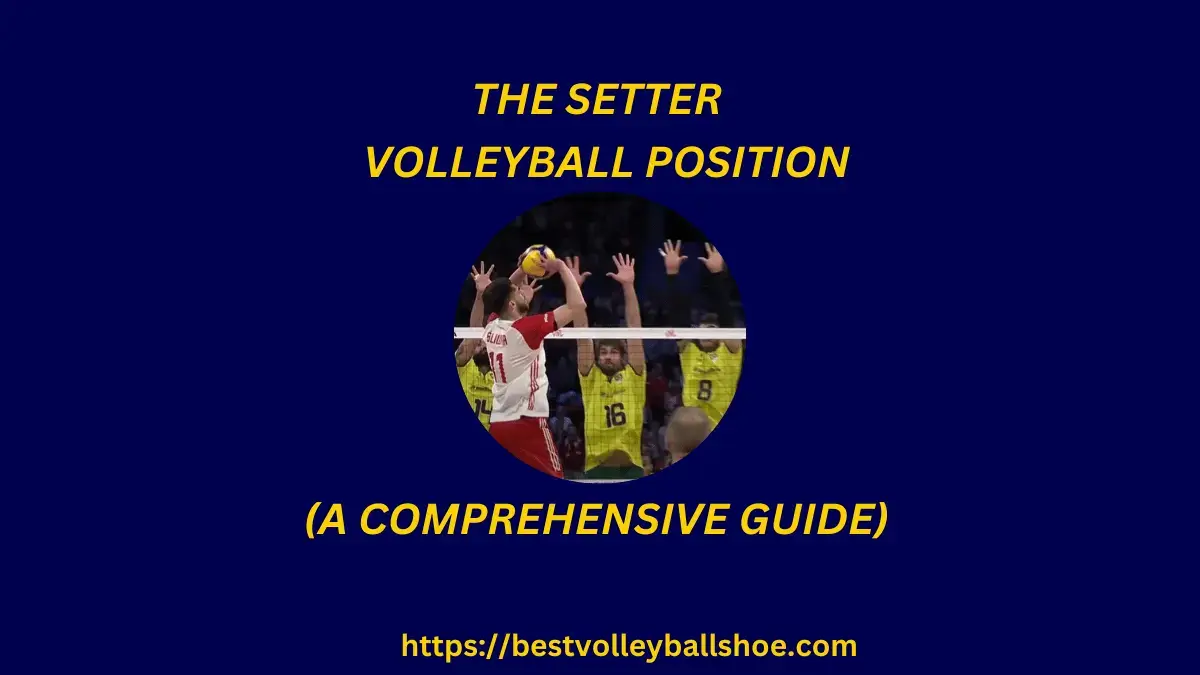
The setter, ideally the recipient of every second ball, is the offense nerve center of the team. Entrusted with vital responsibilities, he is the most important player on the team and the toughest volleyball position to play.
If you are a volleyball enthusiast and wanna read some authentic, complete, and well-researched information about the setter volleyball position, then you are in the perfect place.
In this article, we will be discussing different basic aspects of the setter volleyball position, including volleyball terms, history, rules, position, rotation, role, importance, qualities, physical attributes, and, the best volleyball shoes for this position.
Finally, we will discuss the recruitment standards and essential tips for becoming a better setter.
So let’s start without delay!
What is a Setter Volleyball?
The setter position is the key and the toughest position in a volleyball team due to its vital role and dynamic responsibilities. The setter’s job is much more than just giving the ball to the hitter. He is the prime contributor and anchor in coordinating the attacks on the opponents and running the whole show.
A good setter identifies the weak area in the opponent team and accordingly passes the ball to the right attacker. He touches the ball more than any other player in the match. Ideally, if the control is decent, the setter will be touching every second ball.
History of Setter Volleyball
The concept of specialized player positions in volleyball has evolved over time. Therefore, the introduction of distinct positions in volleyball is not attributed to a specific date, but rather to the sport’s development over time.
The introduction of the setter is attributed to the inception of set and spike rules in the Philippines in 1916. The player responsible for setting the ball was designated as “Setter.”
The set and spike rule gave birth to the rule of three hits, allowing a maximum of 03 hits for returning the ball to the opponent’s court. The role of the Setter was to toss the second ball in the air for the spiker to kill.
Terms for the Setter Volleyball
Set: An action of the setter where he directs the volleyball ball to the area near the net, for the row hitters to spike the ball into the court of the opposing team
Dump: The return of the second ball over the net by the setter (front row) to the opposing team without setting it for the row hitters on the third ball. Importantly, the dump cannot be carried out by the back row setter.
DO YOU KNOW
Setters are the most important player in a volleyball team because of their critical role. Therefore, most coaches around the world preferably build their teams around this key player. In my opinion, this makes sense because setter volleyball is the nucleus of a team.
Rules for the Setter Volleyball
Setters are bound to follow the following rules; otherwise, their team may lose a point as a result of the penalty imposed by the referee.
- A setter must touch the ball with both hands simultaneously.
- During a set, the setter can hit the ball once.
- They can also hit the ball their hit is called a dump.
- The setter volleyball can’t attack, block, or hit the ball above the net while playing as a back-row setter.
- He can’t jump up to hit the ball with the body elevated above the top of the net.
Playing Positions and rotation of setters in the court
Setters typically play on the right side of the front row or right back in the back row, mainly to set the ball for the hitters to spike.
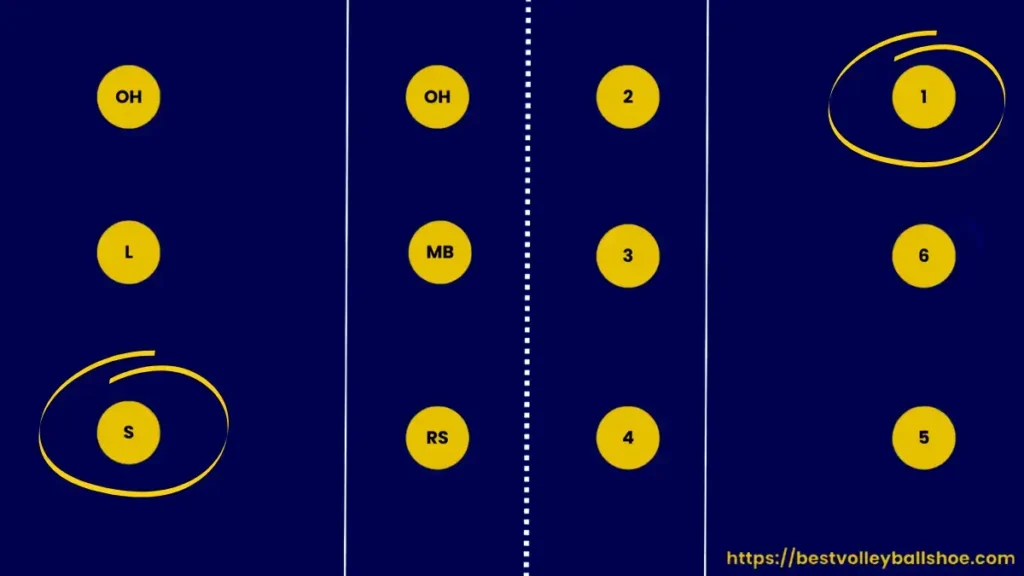
The serve from the opponent is not received by the setters when he plays in the front row. In this case, he will receive the pass and set for the suitable hitter i.e. outside hitter or opposite hitter.
While playing in the second row he digs and passes the ball to set for a hitter. However, they are not usually focused diggers.
Usually, Setter volleyball are not there to pass or receive serve because they are required more to set the ball rather than pass. If the Setter is entrusted the responsibilities of passing the setting will suffer.
Depending on the formation the number of setters may be one or two. In two setters’ formations, both will be positioned opposite each other.
You may see the below video for a better understanding of setter rotation.

Rotation: The setter rotates clockwise on a volleyball court. The rotation of the setter is planned in such a way as to keep him near his base position i.e. 2
Role and Responsibilities of a Setter Volleyball
Setting the ball
The prime responsibility of a setter in volleyball is to set the ball for the hitters. Depending on the situation and needs of the team, the set can be of different types. Here is the list of a few:
- Front Set: A most commonly used set, in front of the hitter to allow him to spike over the net with free and straight arms.
- Back Set: The set which is set behind the hitter, usually when he is in position to spike cross the court
- Quick Set: These are fast sets and are used to surprise the opponent blockers. These sets are speedy.
- Dump Set: The set which is dumped on the opponent side of the court by the setter. It is done when the setter does not find any hitter in a suitable position to spike, or he is unable to set.
The setter is responsible for every Second Ball
Ideally, the setter receives every second ball in the game. Upon receiving the serve, the receiver defense passes the ball to the setter to set it for the suitable hitter in the front row for the spike.
Running the team’s offense
The most important role of the setter in volleyball is to run the team’s defense. The player at the setter position orchestrates the team’s offense. Having a ball in hand, he has to decide which of his hitters is in the best position to score a point.
However, this isn’t always possible. For instance, if he digs the ball in the back row of the court. He will definitely pass the ball instead of setting.
Understanding of Game Plan
The setter needs to know and truly understand the game plan. This can be communicated to the team through the coach, but it also can have to do with preparation before the game so the setter, as the leader of the team’s offense, is more significant than all other players on the court.
Blocking and Hitting the Ball
While standing in the first row, the setter may have to play as a blocker, and their position is in front of the outside hitter of the opposite team. Occasionally, they may also require facilitating the middle blocker.
Surprisingly, he may have to hit the ball while playing in the first row especially when the ball is set by any other player.
However, he may hit the second ball, if the set doesn’t seem suitable and his hit is called dump.
Serving and Defense
When the setter rotates in the backcourt, he has to perform the responsibility of serving and defending.
In the backcourt, their primary responsibility will be to dig and pass rather than set.
Set the ball to a Suitable hitter
As I have stated earlier, the setter touches the ball more than any other player. So, they need to ensure that they are putting their row hitters in the best position to score consistently and precisely.
Sometimes the pass is perfect, and sometimes it’s not, but a great setter can take any pass in any situation and put the ball in the same general area every time.
Importance of the Setter Volleyball
Being an orchestrator and leader of offense in a volleyball team setter is the lynchpin in the team’s offense. A good setter increases the hitting efficiency of his team by his quality sets.
On the other hand, the bad performance of the setter reduces the offensive potential of a team. The low-quality and predetermined sets are likely to be blocked by the opponent’s defenders
Important Skills to Master for a Setter Volleyball
There are 06 volleyball skills, i.e., serving, blocking, digging, attacking, passing, and serving, as far as different volleyball positions are concerned. For a setter, there are 4 skills that he needs to master, including:
- Setting
- Digging
- Attacking
- Serving
Qualities & Strengths of the Great Setters
Leadership and presence on the court
Being an epicenter of offense, he must have good leadership qualities. In most of the instances, the setter also leads the team as a captain.
Therefore, they are cognizant of the capabilities of their players to best utilize them in the game.
A good leader brings the team out of crisis by utilizing its resources at best, and the same is the case with world-class volleyball setters.
They encourage their best and in-form wing spiker to capitalize on the opportunities.
Anticipation
Anticipating where the ball will be after a pass enables setters to position themselves optimally for effective sets. Being a leader, one should be able to foresee the opponent.
Identifying the weaker opponent and making quick decisions for the dump is a sort of intuition that a good setter has.
Identifying the Opponent’s Weakness
A good setter has a critical eye on the opponent’s defense and his sets are accordingly targeted. For instance, if one of the blockers of the opponent team seems weak in blocking, under pressure, or less experienced.
The setter will ask and set for his wing spikers to target the weak blocker to obtain maximum points.
In addition to the weak blockers, he also analyzes and points out the weak defenders to his hitters.
Unpredictable sets
Great setters are unpredictable in their sets. If the opponent predicts the sets then there is a likelihood of spikes getting blocked.
The body of the posture of the setter tells everything about the place of the set. Like if it is leaning forward, it shows the set in front of the setter to the outside hitter.
When the body is in a neutral position, it opens up the possibility of the set being omnidirectional. Nevertheless, achieving this level of versatility can be challenging, and it’s precisely the ability that distinguishes a great setter.
Communication
Good communication skills with the team inside the court and with the coach outside the court are the key to success.
Consistency
He receives every second ball on his side; inconsistency may cause damage to the point table of the team.
Quick Decision-Making Power
This is what differentiates a good setter from a great setter. There is a very limited time to set the ball to the appropriate hitter. Therefore, quick decision-making is very important to capitalize on the opportunity to make valuable points.
A good setter knows if it is wiser to set for the wing spiker or dump the ball into the opponent’s court. If the setter is quick in decision making he will take a split second to decide. Importantly, most of the successful dumps are sudden and surprising for the opponent.
Multi-Tasking
The setter may have to perform different roles according to the situation. So, he should be a good all-around player with strengths in many skills like defense, serving, hitting, and blocking.
Handling the Pressure
It is very easy to perform in normal circumstances, but the real test of any volleyball player is in a pressure situation. Considering the importance and vitality of the setter volleyball position, a setter should be best at handling pressure.
Importantly, it seems pretty justified that the more responsibilities and core positions you hold in any walk of life, the more vibrant and mentally tough you have to be
Physical Attributes of a Volleyball Setter
Agility and Strength
Agility is essential for ensuring quick movement in setting the difficult ball. Being agile helps the setter to reach the ball with more speed than the slower one.
On the other hand, strength is important to set the ball at optimum height.
However, these are not mandatory and built-in attributes for a setter, as these attributes can be developed with training and hard work.
Height
Height is an important physical attribute of a setter. The tall setter adds depth to the team in terms of setting, blocking, and hitting. A tall volleyball setter with high reach can be effective at the net for blocking and hitting.
Similarly, a taller setter can reach the higher balls and set them to the hitter in a more advantageous position. Height also affords a good view of the opponent’s side of the court. Ultimately helping to devise a better offensive strategy.
Although a setter doesn’t need to be tall, a shorter setter volleyball has to work hard compared to the taller ones.
Considering the NCSA height standards of 05 base volleyball positions the Setter Volleyball is the 4th tallest player.
It is noteworthy, that the height difference between liberos and hitters is way more than setters, whereas setters are near in height to the outside hitters.
Here is the comparison graph to explain it all. The height difference between setter and libero in men and women is 10 and 09 cm respectively.
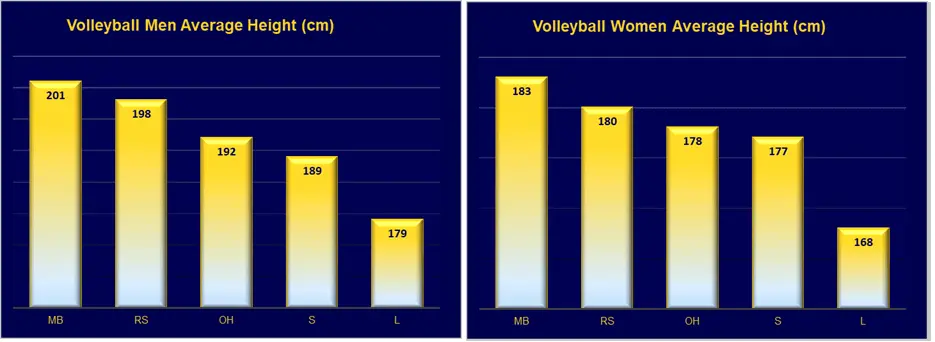
Jumping Ability
Height is a significant parameter for the short setter. Jumping ability can fulfill the space of height. For instance, keeping all other factors aside, a 6-foot setter with 11 feet of blocking reach is better than a 6.5-foot setter with 10.5 feet of reach.
A higher jump increases the reach and efficiency in blocking and hitting. This a skill and may be developed with hard work and technique, but those having it as a physical attribute are on the better side.
Physical Fitness
Decent fitness levels are a prerequisite for every athlete. However, it is a secondary attribute, as it can be developed later with training and hard work. However, it does mean to be bulky and lazy.
Recruitment Standards for Volleyball Setters at Collegiate
I have briefly described various introductory aspects of the setter volleyball position including introduction, history, rules, role and responsibilities, qualities, and physical attributes.
The abovementioned information mostly covers the basics and is generic for all readers. However, from this section, I am addressing those who are looking for a career or who have plenty of experience as a volleyball player. Here are the various guidelines for the recruitment of a setter volleyball at the college level in the USA.
According to the NCSA, the recruitment standards for the women setters are given below the graph. The prime factors for recruitment include
- Height,
- Standing Reach
- Attack jump
- Block Jump
- Vertical Jump
- Experience
Recruitment guidelines for Women:
As per guidelines, the average height for a volleyball setter at the college level in the USA is 177 cm, standing reach 227 cm, attack jump 271 cm, block jump 273 cm, and verticle jump 576cm.
As regards the experience, a woman setter volleyball should have national and open-level club experience. This is to gauge the knowledge of the game and position.
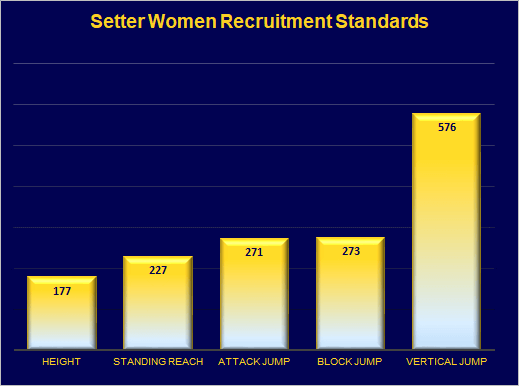
Recruitment guidelines for Men:
The recruitment guidelines for men’s volleyball setters aren’t formally available like women. However, the few stats that are available include height and approach jump. The details of these stats are as under:
Height
Depending on various playing levels and divisions of NCSA the average height for a setter volleyball player is 189 cm or 6’2”.
This data shows that the setter volleyball is the 4th tallest player after middle opposite and right side hitters. On the other hand, he is also not the shortest one he is taller than a libero.
Approach Jump
The average approach jump for a setter is 10’8’’.
Experience
Depending on the playing level and division a setter should have an experience of 3-5 years of a national or elite club in the USA.
Best Volleyball Shoes for Setter
Like every player, the setter volleyball requires a pair of appropriate volleyball shoes. Considering this I’ve given my best recommendations for the volleyball shoes for setters. Moreover, I have also written a detailed article on the Best Volleyball shoes.
Mizuno Wave Lightning Z6-Best Volleyball Shoes for Setters
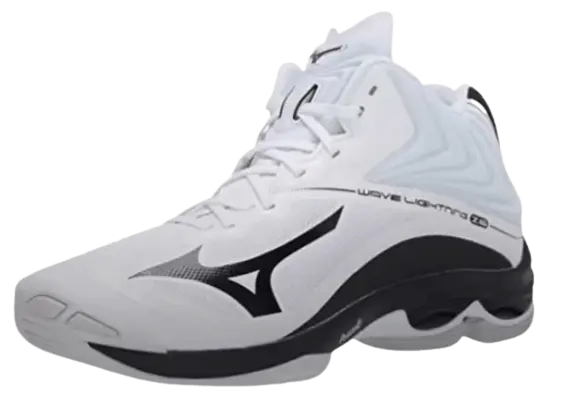
Mizuno Wave Lightning Z6 Mid Top
Premium Mizuno volleyball shoes—lightweight, explosive, comfortable, and highly breathable, making it an excellent choice for agility and precise movements on the court
Knee Pads
How to become a good volleyball setter? Tips for Beginners
Always Master the Basics first
It is essential to learn and master the basic setting skills first and then move to the others.
DO Extensive Practice
It is a very simple rule that if you want to be the best in a specific field then you have to work hard and more than your competitor. Practice makes a man perfect. The more you practice more your skill gets near perfection.
Use the best & perfect setting Equipment.
Always choose the best equipment for practice. You can use the setting practice net and weighted volleyball for improving and polishing skills:
A Setter Target Net
A setter net is like a special tool for volleyball setters. It has marked spots that help you practice where to put the ball accurately.
Using it, you can work on your footwork, and timing, and get better at setting the ball just right.
Another benefit of this is the ease of use and carry. You may use it for practicing at your home by placing it in an appropriate place.
Key Features
Weighted Volleyball
Using a weighted volleyball specifically for setting practice can be a game-changer. It helps build strength in your fingers, wrists, arms, and shoulders.
It enhances your ball control and touch while set. The added weight improves your muscle memory, making your sets more consistent, and when you switch back to a regular volleyball, your confidence in your setting abilities shoots up.
However, it is important to incorporate it sensibly into your training routine to avoid overexertion.
Mikasa MGV500 Heavy Weight Volleyball
Learn from your mistakes and others’ strengths
Do a SWOT analysis of yourself and your competitor. This will help you in identifying your strengths and weaknesses. Additionally, it will also help you in understanding the skills and strengths of others.
The best way to do this is to watch and observe the videos of the best setter at your level. Later on, compare their skill and way of playing with your own game,
Practice reading the defense
Practice communicating with your hitters
Hitters are dependent on the setter for quality sets to kill the ball. Therefore, the coordination is of prime importance. To become a good setter, you should practice codes and signals with your hitter about the game.
Effective communication will help in accurately executing strategic plays and ensuring that hitters understand their roles. Moreover, it will also minimize the errors on the court.
Watch experienced setters
Watching videos of experienced volleyball setters can significantly enhance your skills as a setter volleyball.
If I am recommending you watch videos of experienced setters, there is a logical reason to support the recommendation.
In fact, these experienced setters have been trained by renowned and top coaches from around the world. Therefore, watching their videos provides a practical demonstration of what they have learned from their coaches, in addition to their own professional careers.
Get feedback from your coaches and teammates
Getting feedback from the mentor or coach is important to encourage your efforts and identify mistakes.
Coaches and experienced teammates can pinpoint technical flaws in your technique and the quality of the set. They can identify issues like hand positioning, footwork, or body positioning that might be hindering your performance.
Once these flaws are identified, you can work on correcting them, which can lead to more precise and effective sets.
Pro Tips for Setting the Ball
The key importance of a player in any game brings with it a lot of responsibility, and the only way to effectively handle that responsibility is through Hard Work.
I think the same applies to the setters; they are the most important players in a volleyball team and probably the most skillful. So, a setter must work hard in developing and polishing the following skills:
The Set should be the Same for One Hitter
A setter should set the ball at the same height, speed, or distance for a specific hitting position or hitter. This is because the different settings every time will confuse the hitter and affect his hitting efficiency.
For instance, if you are an outside hitter and score a point after receiving a fast set. The next time, you will expect the same type of fast set, but if the set becomes high, you have to slow down for a while before hitting.
This may result in the building of a double block from the opposite team and the likelihood of an inability to score. Moreover, it will also confuse you about the sets that you will be receiving next time.
Don’t Let Your Opponent Know Where you are Going to Set
It is crucial to hide the predictability of your setting. If your opponent predicts the position where you are going to set, more are the chances for the hitter to be blocked.
For this purpose, body position is very important while setting. If the setter’s body is leaning forward, it means he is going to set in front of him. On the other hand, if it is lean backward, the set will be flying behind the setter.
However, if the body is in a neutral position, then the likelihood of setting can be omnidirectional. It’s not an easy task to keep the body position neutral while setting, but this is the skill that makes a good setter.
Shuffle Your Attack Scheme
To hold the opponent blocker in the middle, a few setters start the game by setting the ball to the middle. Afterward, they start to set at position 2 or 4.
Few setters prefer to set at certain positions or to certain players, this may make the action predictable. In this situation, one should keep an eye on strategy in a match, especially in a tournament.
Understand Your Hitters and Their Need
The setter needs to understand their hitters individually and what their needs are. Different hitters like different types of sets, some hitters like the ball higher due to their height whereas some may like the lower.
On the other hand, few players like the ball fast, others like the ball a little further from the net to open things up, and allow them to see what’s happening on the other side. In short, the setter needs to know who their hitters are and what they need best to be able to score.
Understand Your Attack Options:
Another important part of running your team’s offense is always understanding the available attack options at all times. Being a setter, you need to know every potential hitter on your side of the net and who you want to get the ball to first-second third.
The first will be the hot hitter who is looking in a good rhythm and repeatedly hitting good shots and earning points. Similarly, the second and third will be in the order of priority in terms of performance.
The setter should keep an eye on the performance of hitters during the game. This will help him in deciding the hitter for spiking. For example, if the outside hitter is blocked twice in a row then it will be wiser to set for the opposite hitter for better results.
Know Opponents’ Defense & Exploiting the Weakness:
Knowing who is blocking on the other side of the net is also very important for a setter. Usually, a blocker can be strong or weak, experienced or inexperienced, tall or short, and fast or slow.
It is essential to identify the weakness in the opponent’s defense as every team plays with strengths and weaknesses. Being the brain of the team, the setter should devise an effective strategy for harvesting the opportunity in the form of weak opponent defense.
For instance, if you have a taller spiker compared to a smaller setter as a blocker in the opponent team. In this case, your hitter has the advantage of height and a better chance of scoring a point. So, setting more to the taller spiker in this scenario may earn precious points.
The offense against two really strong, experienced, tall, or fast blockers probably isn’t the best choice, so having the presence of mind to know who the blockers are on the opposite side of the net in addition to your attackers is important.
Key Performance Indicators (KPIs) for a Setter
Here are a few key performance indicators of a setter volleyball :
Set Success Rate:
Percentage of the sets successfully hit by the spikers Set Success Rate. A High percentage indicates the perfection of the set.
Assists
Percentage of the sets converted into the kill by the hitters. A high percentage is an indicator of the setter’s skill in a valuable and fruitful setting.
Pass reception:
Percentage of the passes successfully received by the setters
Setter Volleyball FAQs
What is the job of a setter volleyball?
The primary job of the setter volleyball is to set the ball for the spiker to kill. He is responsible for running the team offense. He is the prime contributor and anchor in coordinating the attacks on the opponents and running the whole show.
Who is the Best Volleyball Setter in the World?
Rezende Bruno Mossa of Brazil is the best setter volleyball in the world. Both of his parents were professional volleyball players. Moreover, his father also remained the coach of the national men’s volleyball team in Brazil.
Can a setter score a point?
Yes, the setter can score a point. The spike by the setter is called a dump.
Can a setter hit the ball?
A setter can hit the ball and the hit of the setter is called a Dump. But this is different from the spike by hitters (outside hitter, middle hitter, and opposite hitter) in a way that the setter can not jump above the net height
Are there 1 or 2 setters in volleyball?
This all depends on the volleyball formations you are playing in. In 6-2 formation there are 2 setters on the other hand in 5-1 formation this number is one.
Can the setter volleyball move before the serve?
Like every volleyball player, setter volleyball cannot switch positions before the serve. It is the basic rule which he has to follow.
Can a setter pass in volleyball?
While playing in the back row the setter has to dig and pass the ball. However, setters are not there to pass or receive serve more because they are required more to set the ball rather than pass. If the Setter is entrusted the responsibilities of passing the setting will suffer.
Why is being a setter hard?
Setter is the key position in volleyball due to its diversified role as a volleyball player. He has to set, defend, and attack in addition to leading and communicating roles simultaneously.
Is the setter allowed to spike?
The setter is allowed to spike, provided that he does not cross the upper border of the volleyball net. The spike of the setter is called a dump.
Are the setter volleyball and the liberos volleyball the same?
setter Volleyball and Libero are two different players and play at different volleyball positions. The base libero only plays in the back row of the court whereas the setter plays in both the front and back row. Moreover, the setter has diverse responsibilities of setting, serving, receiving, and blocking.
